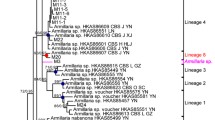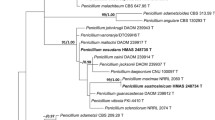Abstract
The sclerotia of Polyporus umbellatus were collected from three locations in Japan and three locations in China. All the collected sclerotia were adhered to by rhizomorphs of the symbionts. When the sclerotium of P. umbellatus was cross sectioned, the internal part of the sclerotium was cream colored, and many black regions surrounding the invading rhizomorphs were observed. The surrounding zone contained string-like, gelatinous masses composed of hyphae, and its outside was brown in color. All isolates were similar in colony morphology and grew well on PDA medium with well-developed rhizomorphs. All the isolates showed typical morphology of Armillaria. The isolated fungi were identified via the ITS region of the nuclear ribosomal DNA sequence. Phylogenetic analysis based on the neighbor-joining method showed that all the isolates clustered with fungi belonging to Armillaria species. Among them, five species (A. sinapina, A. calvescens, A. gallica, A. cepistipes, and A. nabsnona) and the symbiont formed a highly supported clade. We report on the case where Armillaria has a relationship in the sclerotium of Polyporus umbellatus.





Similar content being viewed by others
References
Anderson JB, Stasovski E (1992) Molecular phylogeny of Northern Hemisphere species of Armillaria. Mycologia 84:505–516
Anderson JB, Ullrich RC (1979) Biological species of Armillaria mellea in North America. Mycologia 71:402–414
Cha JY, Igarashi T (1995) Armillaria species associated with Gastrodia elata in Japan. Eur J For Pathol 25:319–326
Chen SY, Chen HY (2000) Collection of mushroom prescriptions. Shanghai Science and Technology Literatures Press, Shanghai, pp 315–327
Czederpiltz DLL, Volk TJ, Burdsall HH (2001) Field observations and inoculation experiments to determine the nature of the carpophoroids associated with Entoloma abortivum and Armillaria. Mycologia 93:841–851
Felsenstein J (1985) Confidence limits on phylogenies: an approach using the bootstrap. Evolution 39:783–791
Fukuda M, Nakashima E, Hayashi K, Nagasawa E (2003) Identification of the biological species of Armillaria associated with Wynnea and Entoloma abortivum using PCR-RFLP analysis of the intergenic region (IGR) of ribosomal DNA. Mycol Res 107:1435–1441
Gibson IAS (1960) Armillaria root rot in Kenya pine plantations. Commw For Rev 39:94–99
Guillaumin JJ, Anderson JB, Korhonen K (1991) Life cycle, interfertility, and biological species. In: Show CG, Kile GA (eds) Armillaria root disease. Agriculture Handbook, No. 691. USDA. Forest Service, Washington, DC, pp 10–20
Imazeki R, Hongo T (1965) Coloured illustrations of fungi of Japan, vol 2 (in Japanese). Hoikusha, Osaka, p 134
Imazeki R, Hongo T (1989) Colored illustrations of mushrooms of Japan, vol 2 (in Japanese). Hoikusha, Osaka, p 139
Jasalavich CA, Morales VM, Pelcher LE, Seguin-Swartz G (1995) Comparison of nuclear ribosomal DNA sequences from Alternaria species pathogenic to crucifers. Mycol Res 99:604–614
Kable PF (1974) Spread of Armillariella sp. in a peach orchard. Trans Br Mycol Soc 62:89–98
Kile GA, Watling R (1983) Armillaria species from south-eastern Australia. Trans Br Mycol Soc 81:129–140
Kim MS, Klopfenstein NB, Hanna JW, McDonald GI (2006) Characterization of North American Armillaria species: genetic relationships determined by ribosomal DNA sequence and AFLP markers. For Pathol 36:145–164
Korhonen K (1978) Interfertility and clonal size in the Armillaria mellea complex. Karstenia 18:31–42
Lee JY (1988) Coloured Korean mushrooms. Academy Press, Seoul, p 258
Morales VM, Jasalavich CA, Pelcher LE, Petrie GA, Taylor JL (1995) Phylogenetic relationship among several Leptosphaeria species based on their ribosomal DNA sequences. Mycol Res 99:593–603
Ohta K, Yaoita Y, Matsuda N, Kikuchi M (1996) Sterol constituents from the sclerotium of Polyporus umbellatus Fries. Nat Med 50:179–181
Ota Y, Matsushita N, Nagasawa E, Terashita T, Fukuda K, Suzuki K (1998) Biological species of Armillaria in Japan. Plant Dis 82:537–543
Roll-Hansen F (1985) Armillaria species in Europe. Eur J For Pathol 15:22–31
Saitou N, Nei M (1987) The neighbor-joining method: a new method for reconstructing phylogenetic trees. Mol Biol Evol 4:406–425
Stamets P (2000) Growing Gourmet and Medicinal Mushrooms, 3rd edn. Ten Speed Press, Berkeley
Swofford DL (2004) PAUP: phylogenetic analysis using parsimony (and other methods), version 4. Sinauer Associates, Sunderland
Taylor DL, Bruns TD (1997) Independent, specialized invasions of ectomycorrhizal mutualism by two nonphotosynthetic orchids. Proc Natl Acad Sci USA 94:4510–4515
Terashita T, Chuman S (1989) Armillaria species isolated from the wild orchid, Galeola septentrionalis. In: Proceedings of the 7th international conference on root and butt rots, vernon and Victoria, BC, Canada, 9–16 August 1988, pp 364–370
Thompson JD, Gibson TJ, Plewniak F, Jeanmougin F, Higgins DG (1997) The ClustalX windows interface: flexible strategies for multiple sequence alignment aided by quality analysis tools. Nucleic Acids Res 24:4876–4882
Wargo PM, Shaw CG (1985) Armillaria root rot: the puzzle is being solved. Plant Dis 69:826–832
Watling R (1974) Dimophism in Entoloma arbortivun. Bull Mens Soc Linn Lyon 43:449–470
Wei Q, Wu GL, Nei JC (1983) Effect of Polyporus umbellatus polysaccharides on glycogen storage, enzyme activities in glyconeogenesis and glycogenolysis of liver in mice bearing hepatoma H22. Zhongguo Yao Li Xue Bao 4:141–143
White TJ, Bruns T, Lee S, Taylor J (1990) Amplification and direct sequencing of fungal ribosomal RNA genes for phylogenetics. In: Innis MA, Gelfand DH, Snisky JJ, White TJ (eds) PCR protocols. Academic Press, London, pp 315–322
Xu G, Fu W, Zhao X (2003) Advances in studies on Polyporus umbellatus in China. J Fungal Res 1:58–61
Yao L, Cheng H, Yang Z (2006) Guidelines for good agricultural practice of Chinese crude drugs (in Chinese). China Agricultural Press, Beijing, pp 1213–1222
Acknowledgments
We are grateful to Dr. Y. Ota (Forestry and Forest Products Research Institute) for valuable information and supplying literature; to Dr. S. Isoda (Showa University) for taking picture of P. umbellatus. We also thank Dr. M. Okada (The Kochi Prefectural Makino Botanical Garden), Prof. S. Terabayashi (Yokohama College of Pharmacy), Prof. A. Suzuki (Chiba University), and members of Botanical Raw Materials Division, Tsumura & Co., for useful information and their suggestions.
Author information
Authors and Affiliations
Corresponding author
About this article
Cite this article
Kikuchi, G., Yamaji, H. Identification of Armillaria species associated with Polyporus umbellatus using ITS sequences of nuclear ribosomal DNA. Mycoscience 51, 366–372 (2010). https://doi.org/10.1007/s10267-010-0053-8
Received:
Accepted:
Published:
Issue Date:
DOI: https://doi.org/10.1007/s10267-010-0053-8




